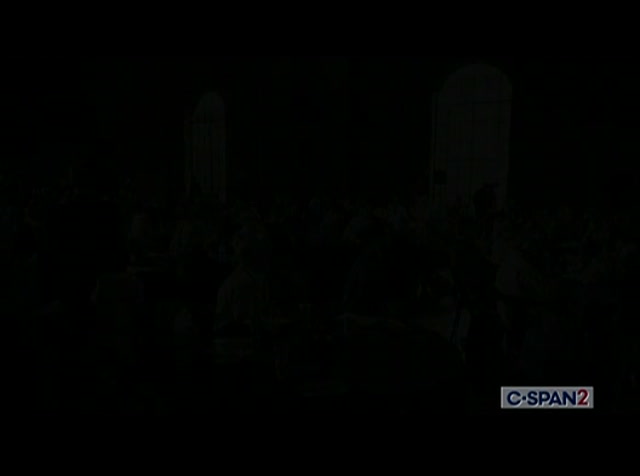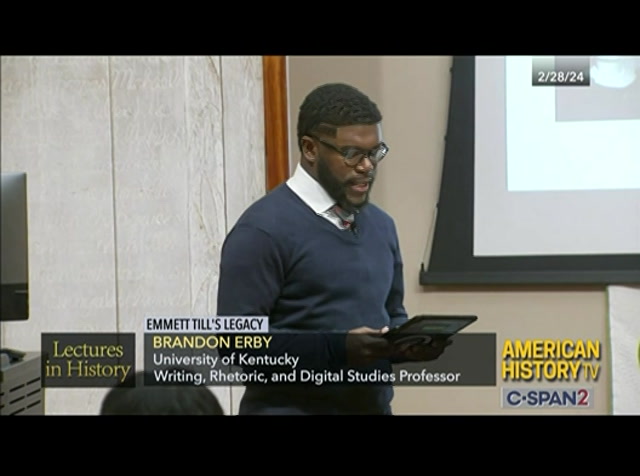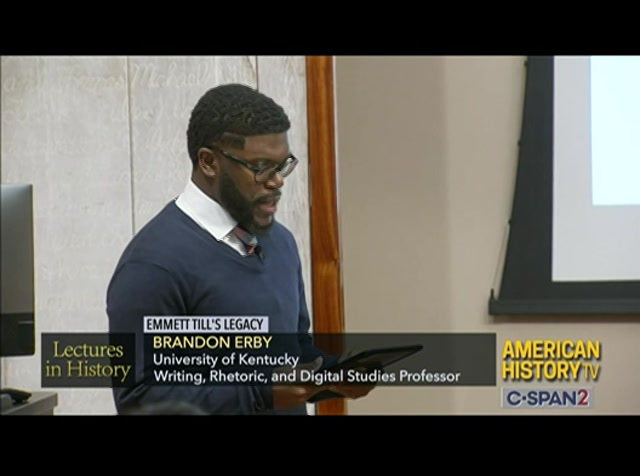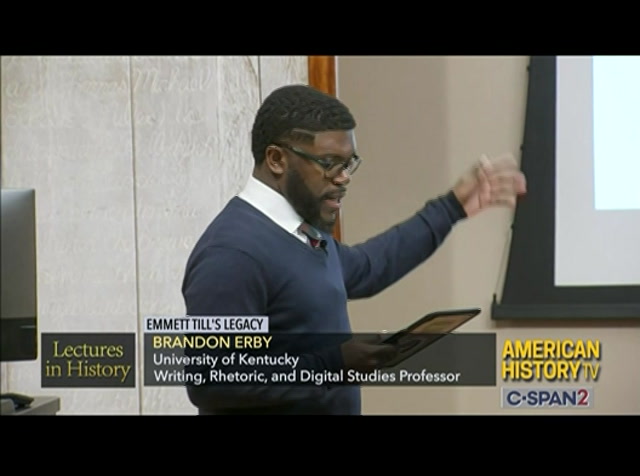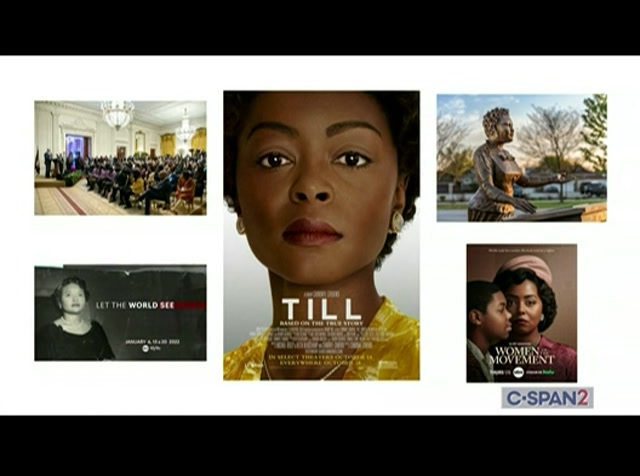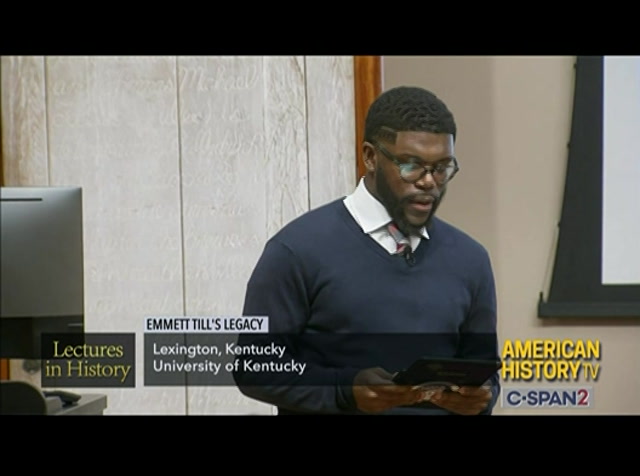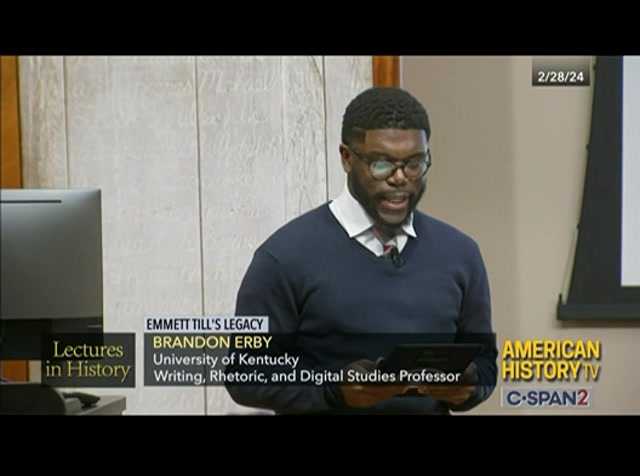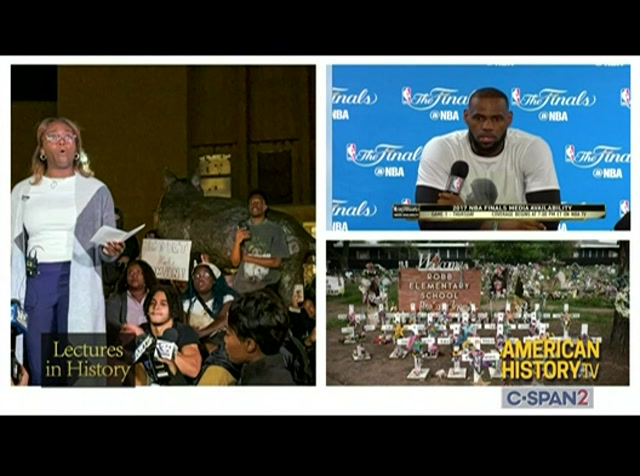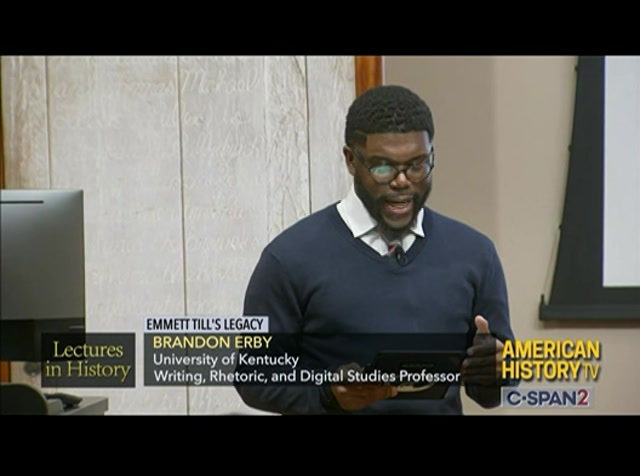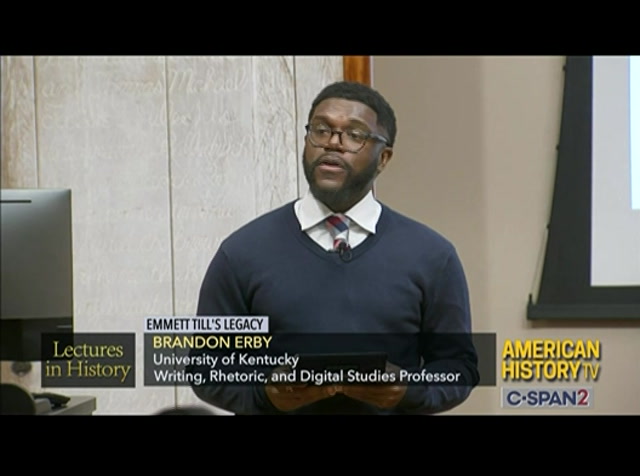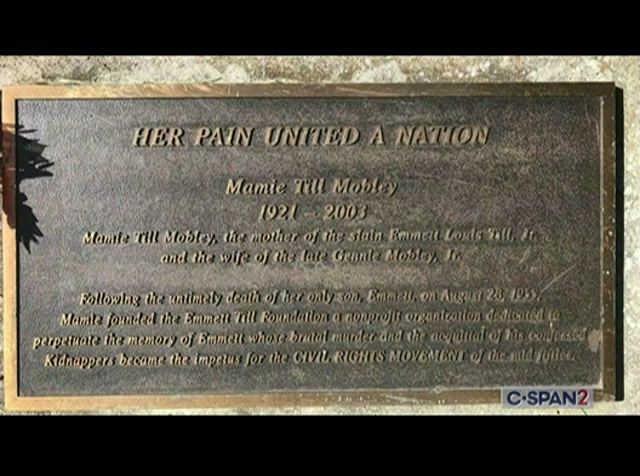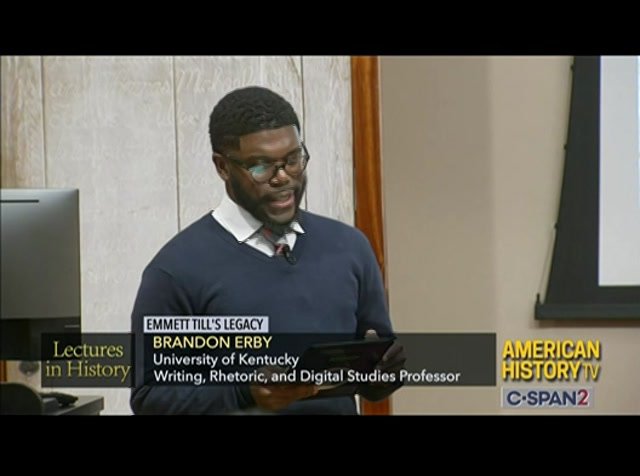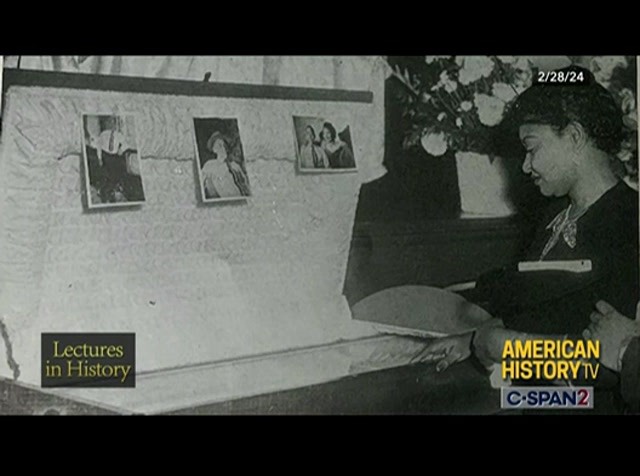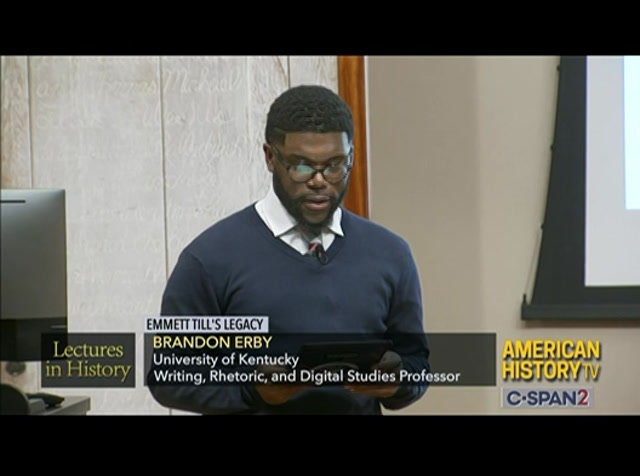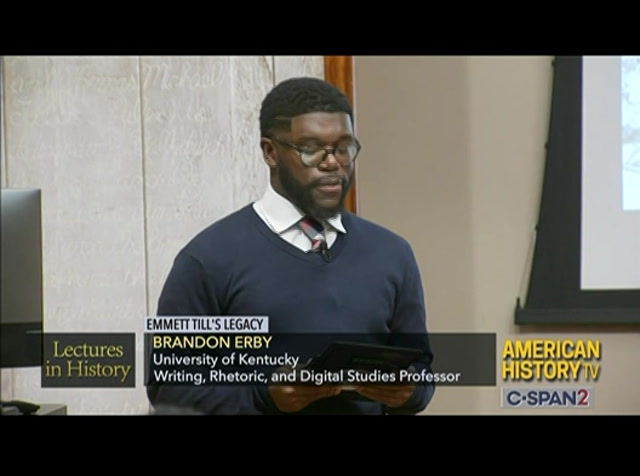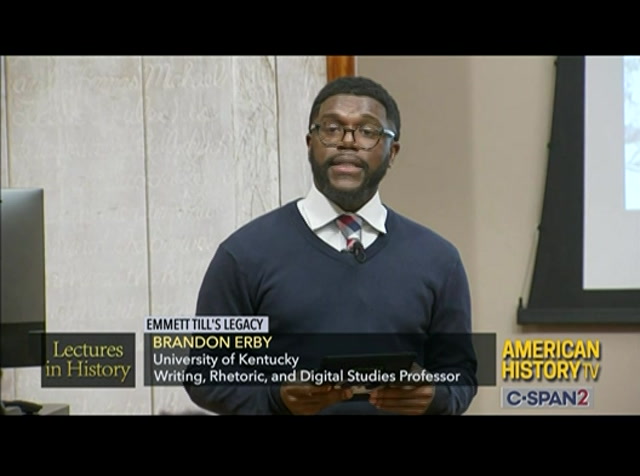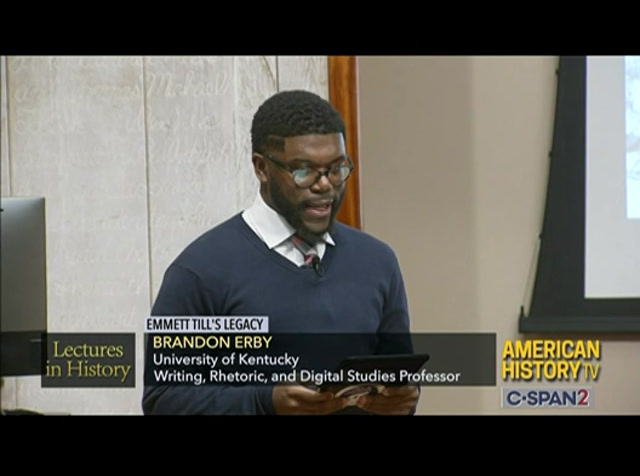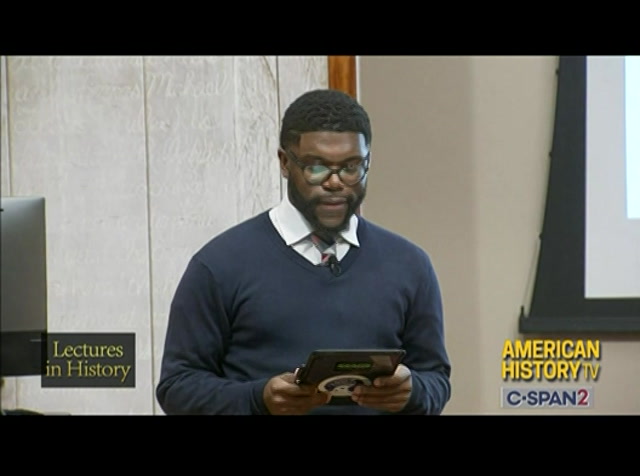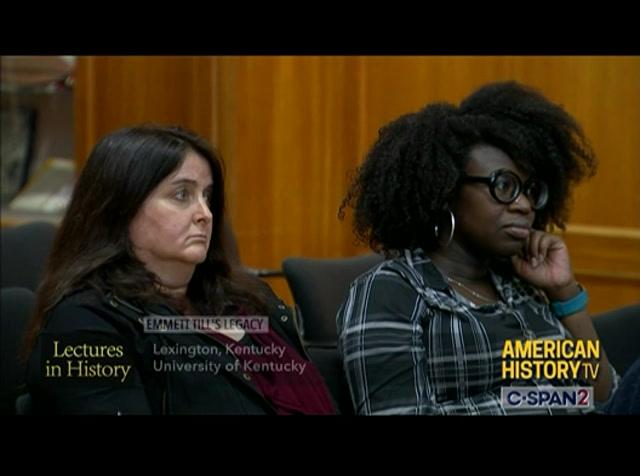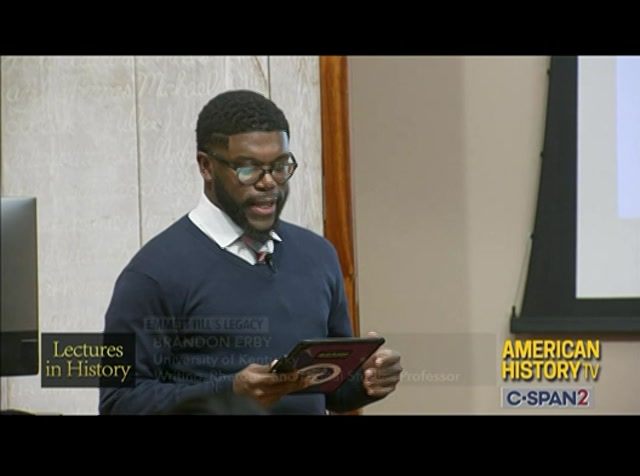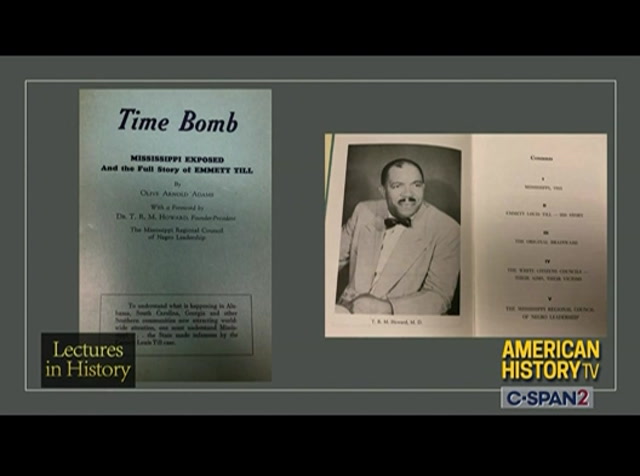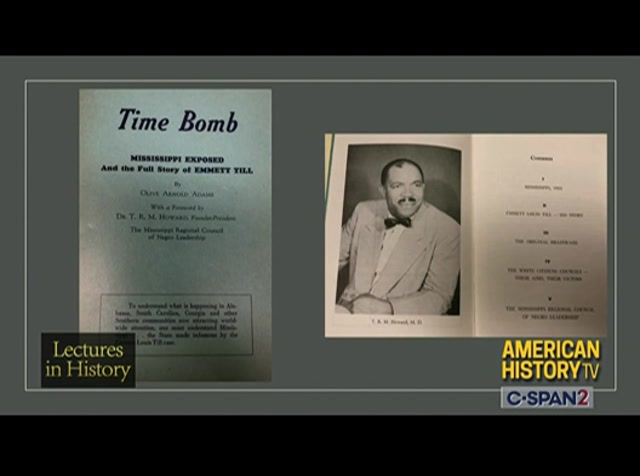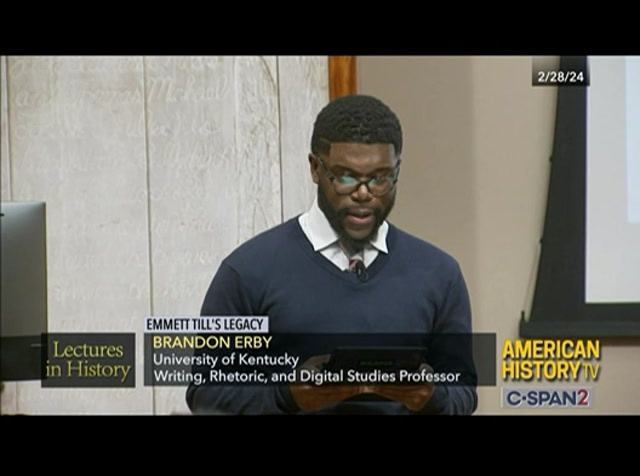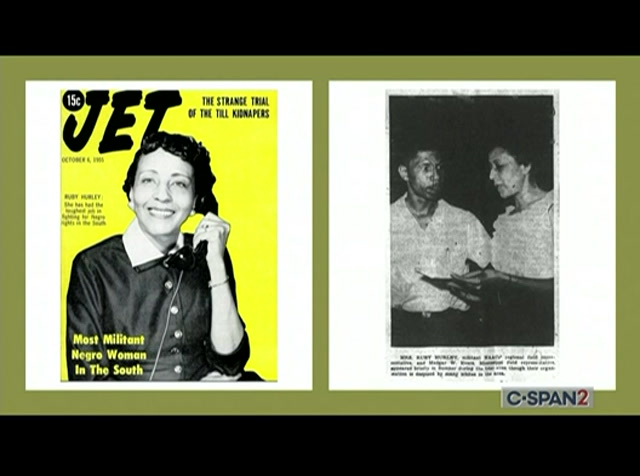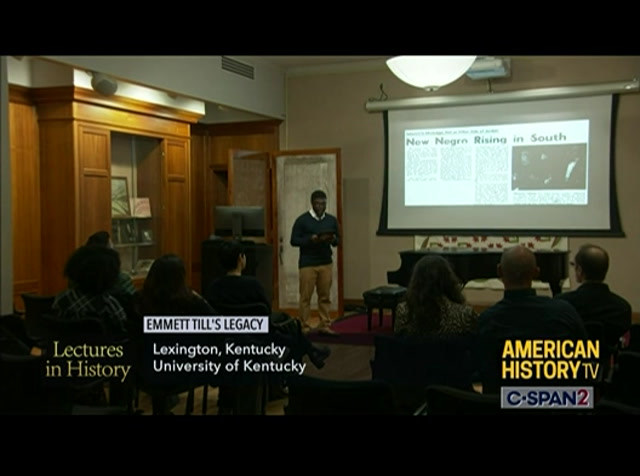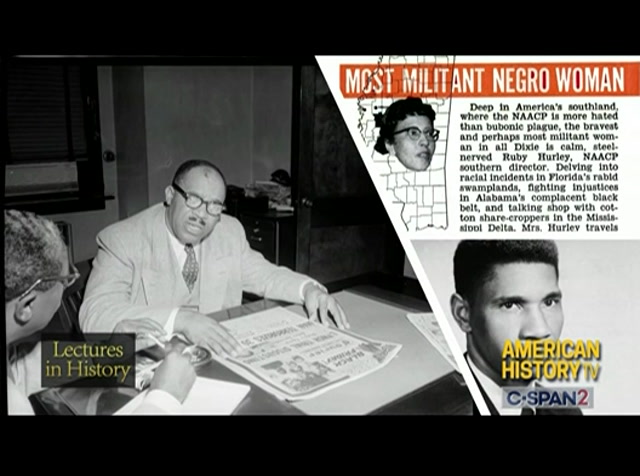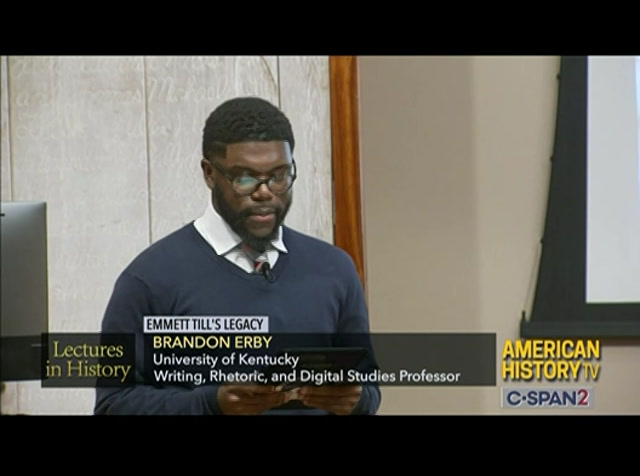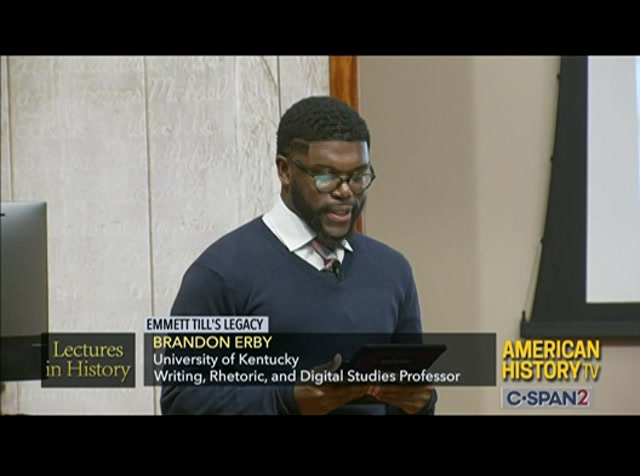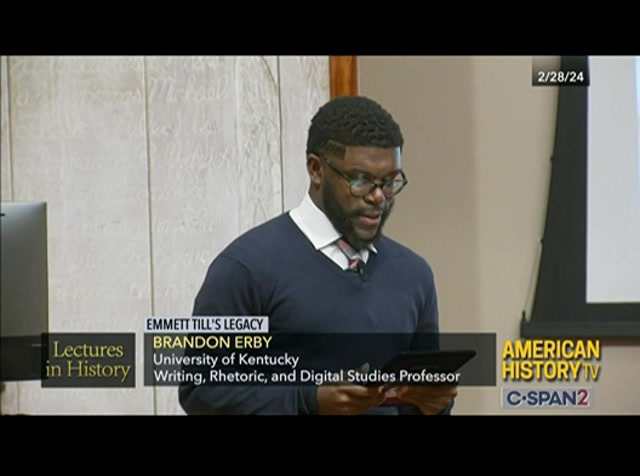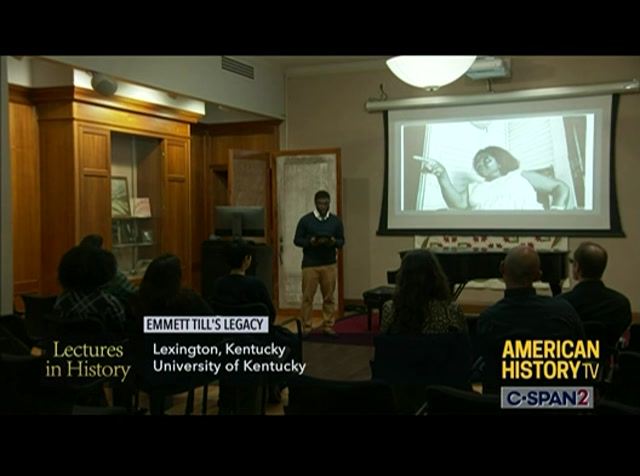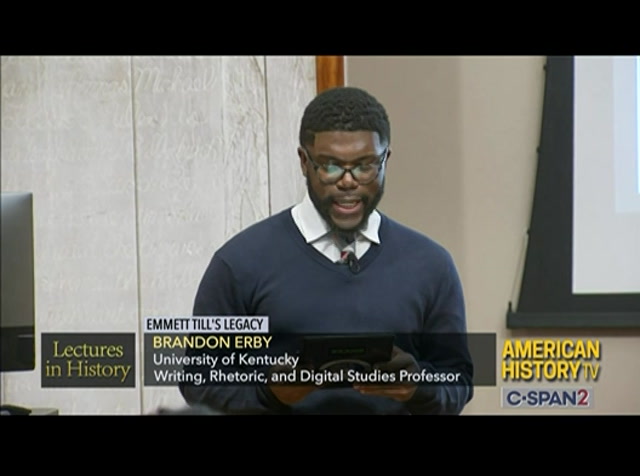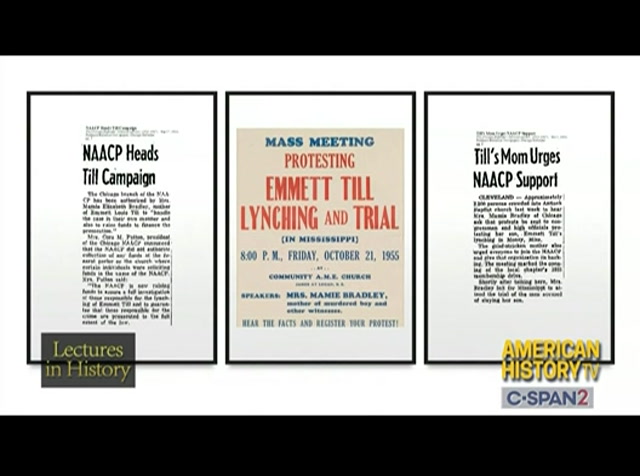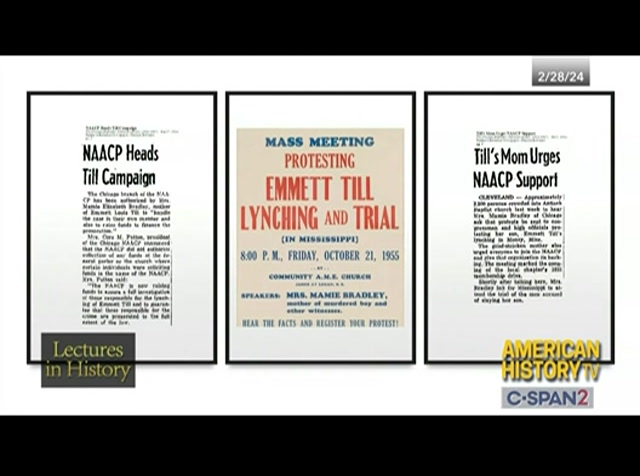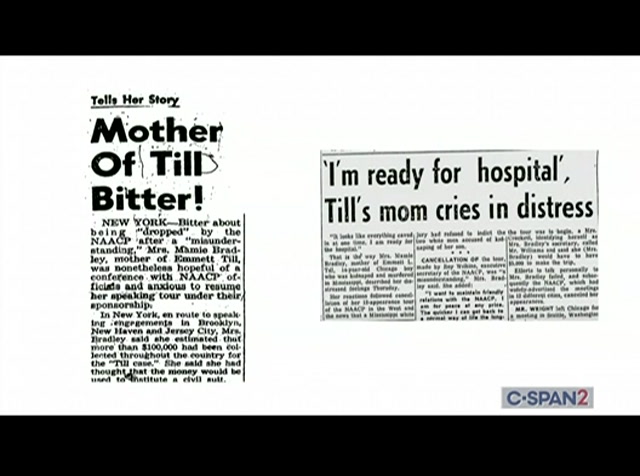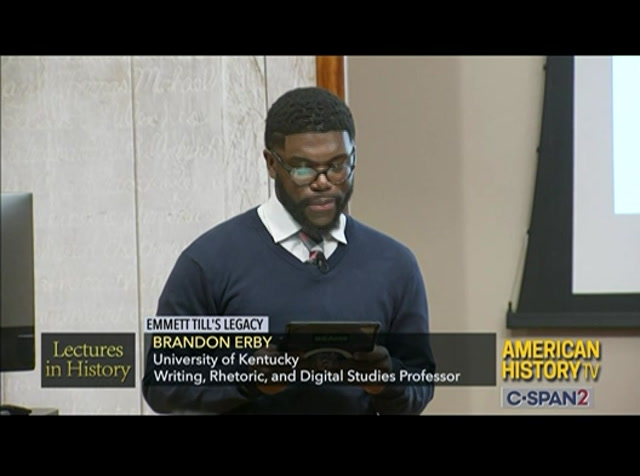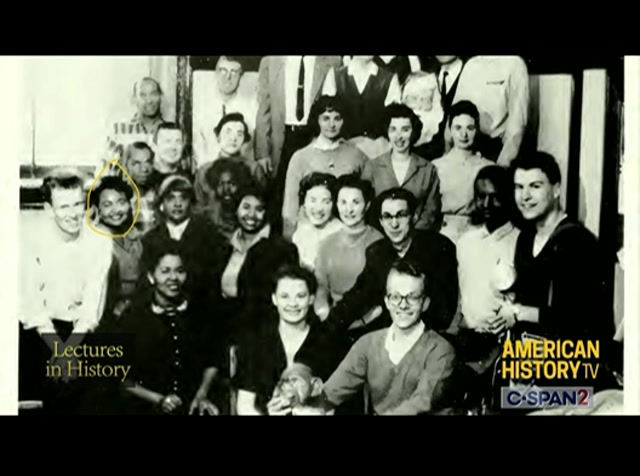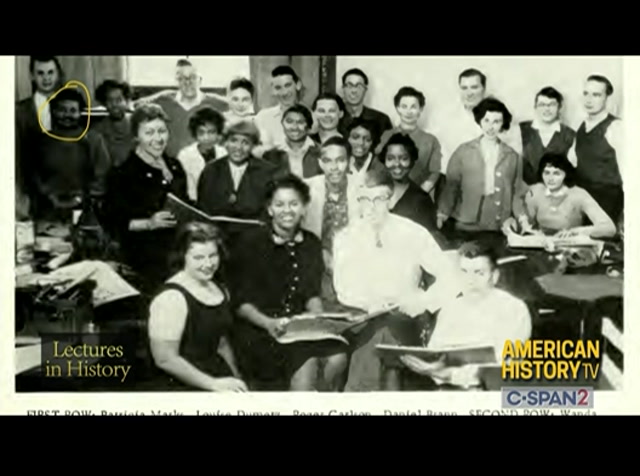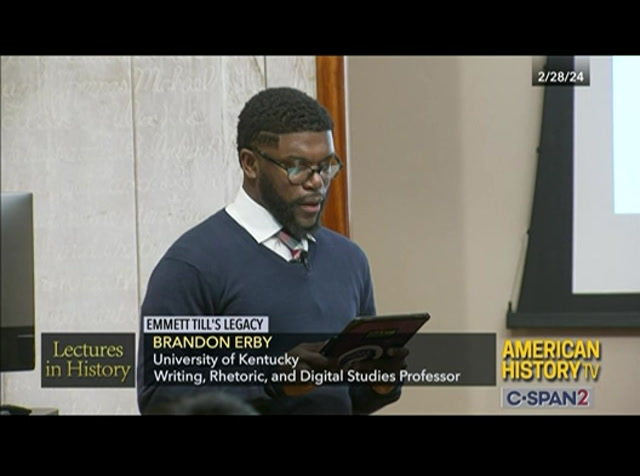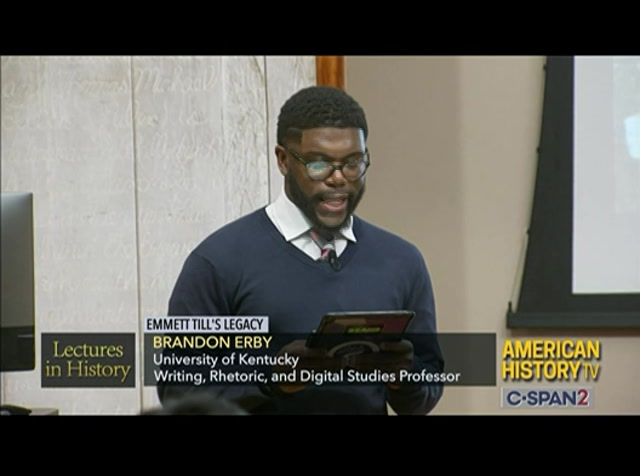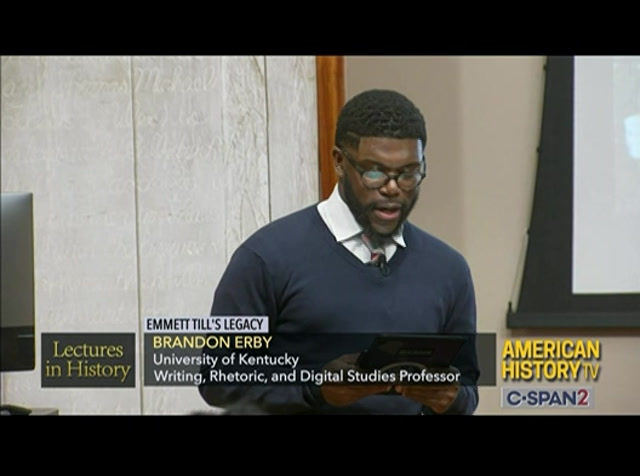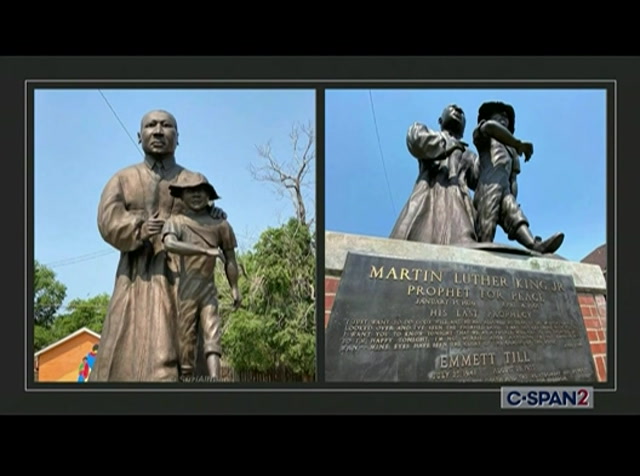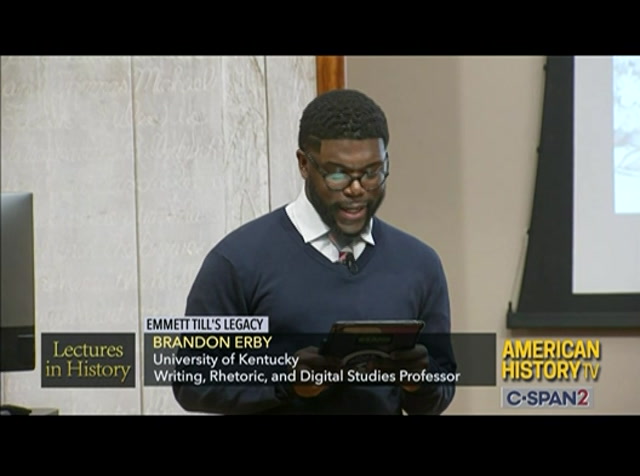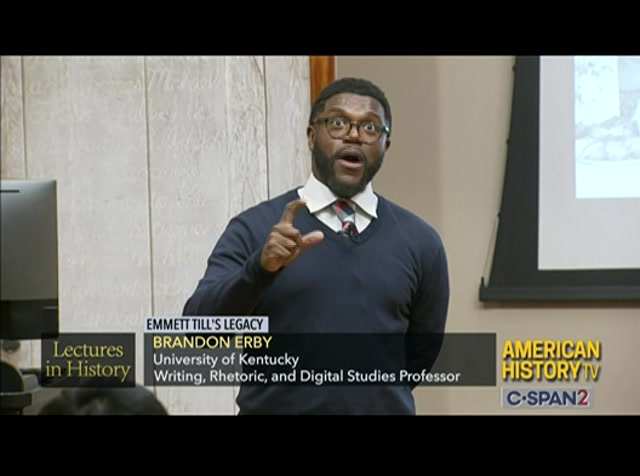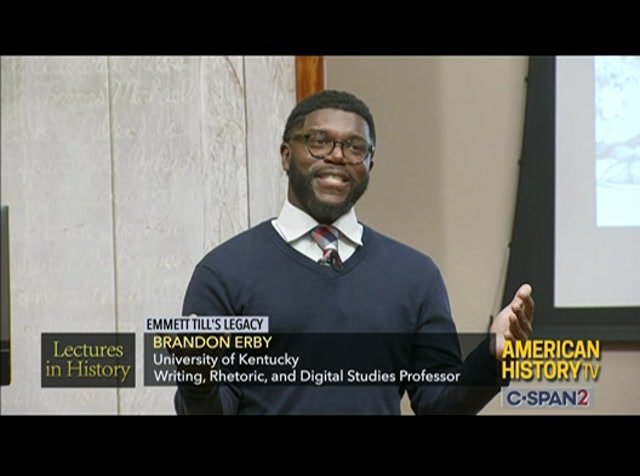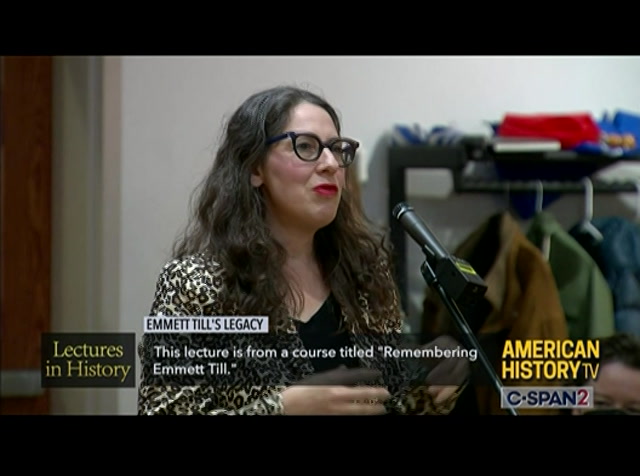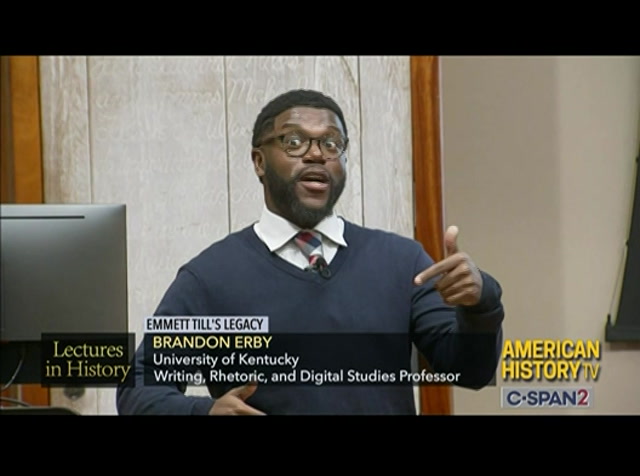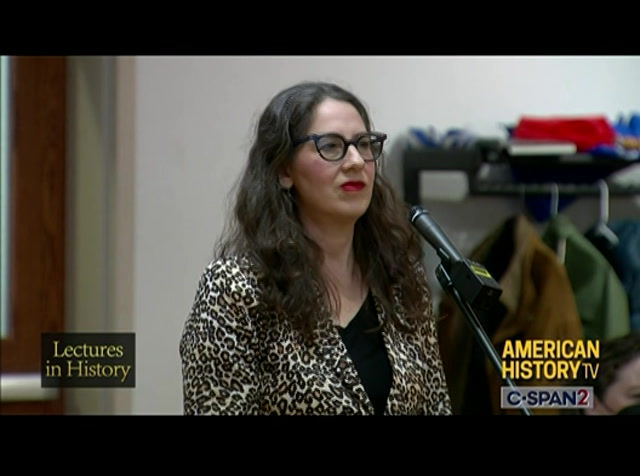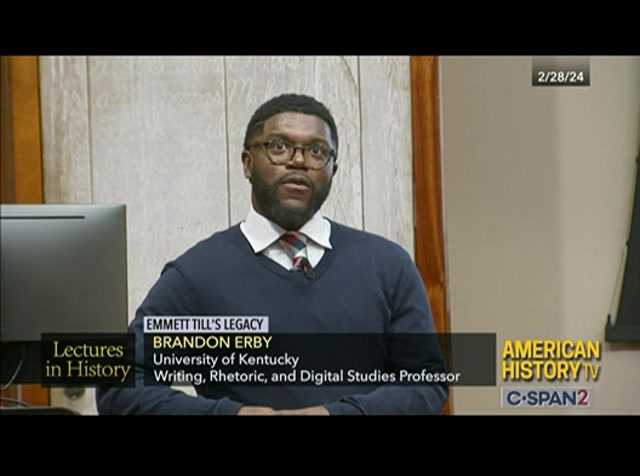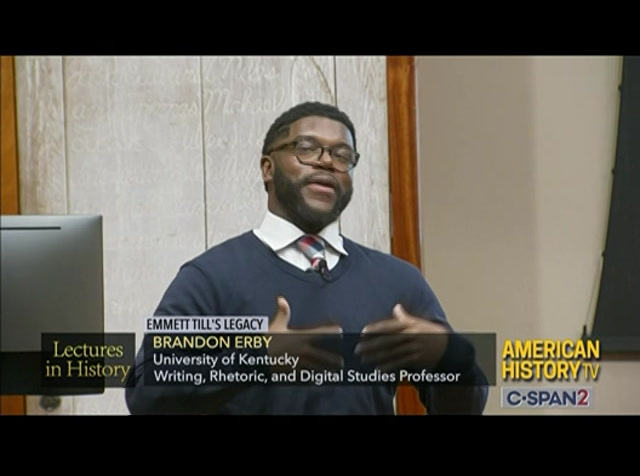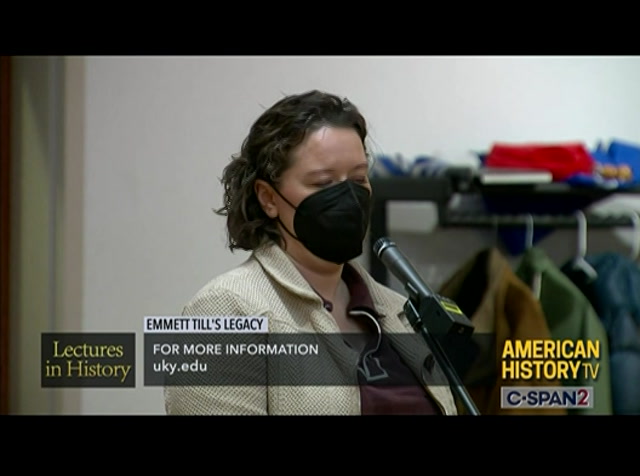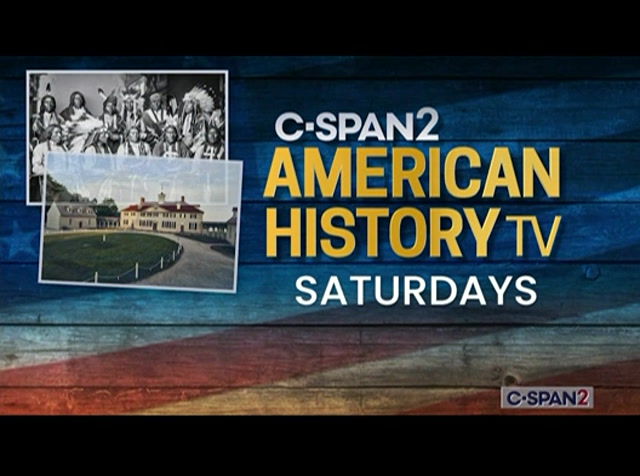tv Lectures in History Mamie Till- Mobley Remembering Emmett Till CSPAN April 26, 2024 4:44am-5:43am EDT
4:45 am
for coming on this very rainy and dreary and cold day last wednesday of black history month. so we're going to celebrate with this topic today. but it's such an honor to really bring this story to you. i think this is a remarkable woman, and i am so honored to feature her work today. so i want to start by thinking about the ways that we are currently living in this age of remembering mamie till-mobley. in the last two years, we have observed the abc limited series women of the movement dramatized the lives and stories of emmett till and mamie till-mobley and make them a sex accessible on television screens, on mobile devices and the streaming platform. hulu unfolding across six episodes over three weeks. women are the movement centers to mobilize activist efforts in
4:46 am
the wake of our son's brutal murder and brilliantly portrays the heroic deeds of the individual communities and organizations supporting our desire to bring awareness to till's death and hold accountable those responsible for its. after. women of the movement aired each week. the three part docu series let the world see immediately followed, providing audiences with another resource to discover more about mamie till mobley's life and how her decision to leave her son's casket open and board and others to invoke the memory of till end their fight for racial justice. during both the heirs of, jim crow and the black lives matter movement. five months after the premieres of women of the movement and let the world see abc news amplify and tell mobley's experiences in the podcast reclaimed the story of mamie till-mobley on october
4:47 am
14th, 2022. the film tiller debuted in select theaters across the u.s. and became the first production about the till case to be distributed on the big screen. as stated on the film's website, it too unveils the true story of mamie till-mobley relentless pursuit of justice and underscore across the universal power of a mother's ability to change the world. as you can see in this left corner, there, president biden also screen the film till at the white house in february of last year. and he remarked this film powerfully tells the story of a mother's loss and a young son's promise. a nation's reckoning about hate, violence and power. a few months later on, what would have been emmett till's 82nd birthday president biden signed a proclamation to create
4:48 am
the emmett till and mamie till-mobley national monument. the traveling exhibit emmett till and mamie till-mobley. let the world see opened in the fall of 2022 at the children's museum of indianapolis and a beautiful statue, as you can see, on the right of mamie till-mobley speaking behind a podium was unveiled on april 29th, 2023. outside of argo community high school in illinois which is still mobley's alma mater. while these projects and occasions are powerfully presented to us as productions that richly contribute to tyll mobley's legacy, they are not the only ones in which tyll mobley's name and work has been invoked in recent memory. although these occasions present holistic narratives that commemorate to tell mobley and her son some cases, unfortunately denote the racial animosity and violence that exist in our society. for example, when a los angeles
4:49 am
home owned by nba superstar lebron james was vandalized with a racial slur in may of 2017, james responded during a press conference by saying that racism and hate, especially for black americans, is our live every day. he also stated that one of the first things he thought of about learning after learning about the vandalism about his property was mamie till-mobley. in his words, the reason that she had an open casket is because she wanted to show the world what her son went through. as far as a hate crime. and being black in america is concerned. james his comments connected to mobley's stance with the responsibility for telling the truth about the work of achieving racial equality in the united states. till mobley's name circulated in the sports world once again in 2022. on the first day of black history month, when brian flores, a former black nfl head coach, filed class action
4:50 am
complaints against the nfl and the new york giants miami dolphins and denver broncos franchises due to their lack of hiring and retaining black head coaches, coordinators and general managers. and the complaints preliminary statement civil rights icon such as martin luther king jr. rosa parks and mamie till mobley were listed to honor the brave leaders that fought so hard to help break down racial barriers of injustice. and i want to point out this left photo here and the father of 2022 uk student kyla spring was verbally and physically attacked on campus by another student, repeatedly calling her a racial slur. so here locally at the university of kentucky, the courage that till mobley, despite displayed decades ago, continues to encourage students today to speak out against
4:51 am
racism. their encounter with miss spring was recorded and after she posted it to her social media account, the online video quickly went viral after days of campus protests and outrage. this spring posted an image of mamie till-mobley lee on her instagram page and wrote that till mobley is someone that she deeply admires and documenting an act of racism and circulating it for all to see. kali spring operated in the tradition of til mobley and other black women who have become leaders of racial justice initiatives and another recent example of tim mobley's memory being spotlighted in a glaring way occurred also in 2022 and the aftermath of an incomprehensible act of brutal violence. the mass shooting at rob elementary school and yvonne, a texas on social media and in the mainstream press. till mobley's decision to let the people see what happened to emmett till was offered as the
4:52 am
latest model for how to reckon with and suppress gun violence in the united states. in a june 20, 22 los angeles times article entitled after you've caught a shooting, people consider an emmett till moment to change the gun debate. the viewing of emmett till's corpse is described as an event that infuriated and motivated people to create social change. as stated in the article, some people believe and emmett till moment could change the course of the country's gun control debate by illustrating the bloody and deadly impact of firearms. the idea of communities and lawmakers seeing gruesome photos or videos the dead children has raised questions about whether it might bolster long awaited traction on gun control measures at the state and federal levels. in the op ed photos of slain children might jolt the us into reality. published in 2022 in the saint
4:53 am
louis post-dispatch. a woman named e.b. writes as outrageous and sickening as it may seem, perhaps if we saw photos of those torn and mangled, divided children with their faces protected, the reality wasn't those. and insulated from the truth. i am a mother, so i don't know if i would be as strong as emmett till's mother was in 1955 when she wanted photos of her slain son to be published. but mamie till knew that horror had to be seen. we need to be shocked to be moved. i mentioned these latter examples today because although they each bring attention to mamie till-mobley legacy, they also underscore her role as a grieving black mother whose response to her only child's cruel death ignited civil rights activism and situated her within the history of the civil rights movement. however, although her decision to open till's casket is
4:54 am
significant, what else do we know about? what were her additional acts of engagement? how does she continue to pursue justice for her son and for others? and 68 years after emmett murder and 21 years after till mobley's death, how are people still adding to both of their legacies? and the ongoing fight for justice? these are some of the questions that i ask in my work on mamie till-mobley. while emmett till's death was major influence on who mamie till mobley would become and, the work that she would do it did not solely define who she was. when mamie till-mobley died from kidney failure on january six, 2003, at the age of 81, almost 50 years after her son's segments of her life and work were remembered fondly in numerous as she was honored in national periodicals such as the chicago tribune and the new york
4:55 am
times. while the recognition of till mosley's life and work is commendable, we must consider how she is represented and remembered the words her pain united a are inscribed on to mobley's gravestone. abouelkassem fitri the alsip, illinois burial ground where emmett till is interred. and although an obituary published five days after mobley's death in the washington post mentions time speaking publicly about her son and his death, it also claims that many black leaders felt her greatest role came at the height of her pain. the decision to have an open coffin. so in this lecture today, my goal is to expand our on mamie till-mobley and portray her as not just a woman painfully grieved the barbaric death of her son, but as a devoted social change agent who was influenced
4:56 am
by a robust african american rhetorical tradition and traditions includes how black writers, thinkers interlocutors and, activists deliberately used communicative acts and texts to influence others to move, act, believe and promote causes for survival and freedom. although mobley is widely credited for her open casket decision and in many ways inspiring a new generation of civil rights activists, we often leave her in this moment and neglect to understand the scope of her work and its impact. i expand how we see mamie till-mobley in my larger book project and over the course of six main chapters i detail the importance of labeling till mobley as one a prepare as i explain how to mobley taught her son about navigating the ways of the jim crow south. richard wright referred to this concept as the ethics of living crow and today iterations of
4:57 am
this tradition live on in what is commonly referred to as the talk that parents with black adolescence to educate them about racism and policing. so mobley was also an orchestrator. she arranged how her son's corpse was to different audiences from the images of him in his best that she painted. till's casket to illustrate the violent ways that white supremacy violated black bodies and disrupted black life. to the images printed in the black press that circulated across the country we must also see till mobley asks three and orator and four and educator due to her, that still story should always be told and taught. given her interest in subjects like english and poetry, and her experiences as a public teacher, playwright on the south end and playwright on the south side of chicago, mamie till-mobley believe that knowledge creation is a transformative because.
4:58 am
she did not confine herself to the classroom. till mobley was also political lobbyists. she was a fighter for racial and was committed to holding state powers accountable for the roles that played in the death of her son. this image here shows mamie till-mobley canvasing on the us capitol a or so after emmett till is killed. and next we must see mamie till-mobley as a four mother. a few years prior to her death, till mobley was asked about her legacy and the role that she played in making the world. a better place. some things are better till mobley remarked. but what happened to my boy? still happens, honey. don't forget that. she told the interviewer. over the last decade or so. the black lives matter movement has centered the deaths of black
4:59 am
youth and adults from martin and michael brown to tyree nichols and breonna taylor. to tell as many of the dominant narratives that circulate why these people were killed just as till mobley wanted us to see her son as a human being first not a victim, a martyr or a racial stereotype. we see similar acts from black mothers today seeking to protect their children's legacies via the complete and truthful stories that they share about them and the ways that they keep their children's memories alive via political, ethical, educational, and community activism and. for the remainder of my time today, i like to share with you snippets of tell mobley as an orchestrator, orator and educator. when we think of the details of the emmett till case, what perspectives our vantage points
5:00 am
get amplified the most. in other words, what do we choose to circulate about this? public knowledge. the case usually unfolds in this way on august 28th, 1955, about a week into his summer of visit to the mississippi delta, emmett till, a 14 year old black teenager from, was kidnaped at gunpoint from his great uncle's home and and murdered by a group of white men led by half brothers. roy bryant and j.w. milo. as a black male, till allegedly had committed one of the south's most egregious offenses flirting with assaulting and whistling at a white woman as punishment for his alleged crimes. till was beaten, whipped and shot in the head. his nude and mutilated body was found in the tallahatchie river on august 31st. barbed wire connected his neck,
5:01 am
a constant fan that weighed in the range of 75 pounds. once till's body was discovered in the tallahatchie river. his mother mandated that his corpse be returned to chicago for burial, a decision that countered the state of mississippi's plans to to immediately and without wide range media coverage. when till's body arrived in chicago till mobley insisted that she identify her son and decided to hold an open casket and subsequent memorial again, ignoring the wishes of the state of mississippi. i've got a job do, she said. when others tried to prevent her from seeing and revealing son's body, she deliberately chose present to present people with an opportunity to bear witness to an act of brutal racialized violence in the american south. mamie till-mobley received the news her son was missing around
5:02 am
9:30 a.m. on the morning of august 28th, approximately 7 hours after he was kidnaped from his bed at his great uncle's home. almost immediately, she assembled a network of people to a sister with handling this devastate situation, including union organizers. the black press and the cp. when till mobley was finally that two have been killed and that her mississippi relatives were preparing memorialize him in the mississippi delta and leave his body there permanently. she firmly said no, i wouldn't want him buried in mississippi under any circumstances, she asserted. she then orchestrated a series of steps to ensure that her son would be laid to rest on her terms. two of these steps, including car included raynor, one of one of chicago's most prominent funeral directors, and asking him to prepare emmett till's body for not only burial, but public viewing.
5:03 am
when raynor failed to dissuade mobley from her decision, he ultimately asked if he should try make teal appear more presentable before being exhibited. no, let the world. see what i've seen. mamie till said. raynor worked on till's face anywhere until mobley committed him for what must have been a challenging and mentally draining task for him raynor had to remove till's tongue and his dangling eye, and he closed his mouth and eyelid which means that the images of two that ultimately haunted all over the world were not as horrific as the actual body that till mobley examined at the funeral parlor. as many as 5000 people saw till's body in the first night that it was made available to the public on friday, september 2nd, 1955. more than 40,000 people view
5:04 am
till's body the next day, the day that chicagoans attended his funeral at roberts temple church of god in christ. loudspeakers were set up outside the church so that the 10,000 individuals waiting in line across eight or more blocks could hear the service and till's burial postponed from saturday until tuesday to give more people the opportunity to see his body, which was available from 6 a.m. to 12 a.m. on these extended days. hundreds of thousands of people walk past emmett till's casket over a four day period. black parents brought their children with them so that they could bear witness to the atrocity to which chicago friends served as pallbearers and nurses were posted near his casket to help individuals who could not contain their composure after they saw the state of till's body. one out of every five people who viewed till's corpse had to be assisted due to fainting.
5:05 am
and as this article says here, all were shot. some horrified and appalled. many prayed. scores fainted and practically. all men. women and children wept. as mamie till mobley put it. people had to face my son and realize just how twisted, how distorted how terrifying race hatred could be, how i menace my son. during his last tortured hours on earth, how it continued to stalk us all, which why people also had to face themselves. they would have to see their own responsibilty to see him pushing for an end to this evil. after till's funeral, many individuals throughout the united states felt emboldened. blame all of mississippi for till's death, and directed their anger towards state. maybe mobley asserted that her son's killing was a habitual act of racial oppression. violence in the southern state. after claimed that the state was going to be held accountable for her son's death, someone is
5:06 am
going to pay this. the entire state of mississippi is going to pay for this. he didn't do anything to deserve this till mobley vowed before stating that till's death was an illustration of an everyday occurrence in mississippi and that navigating state was like walking into a den of snakes. perhaps the most scathing response of all came from acp executive secretary roy wilkins. wilkins, mississippi officials of fostering an environment of racial inferiority for african americans in the state and argued that till's killers entitled in the state to maintain white supremacy by murdering children. the killers of the boy felt free to lynch him because there is in the entire state no restraining influence of decency, not in the state capital. among the daily the clergy, nor any segment of the so-called
5:07 am
citizens, wilkins declared when it was time for him only to attend the murder trial for her son's accused murderers in sumner, mississippi. she resided with dr. tim howard, a wealthy physician, gifted orator and the founder of the regional council of -- leadership, a premiere civil rights organization active in the mississippi delta. there will be hell to pay in mississippi. decent citizens are not going to continue to be treated like this dr. howard announced after learning about till's murder. as seen in this publication in which dr. howard wrote foreword. mississippi was as a ticking time bomb and epitomized the savagery that characterized the us south. and i'll just add when emmett till killed in august of in august of 1955, he was just latest of a string murders that were happening in that summer.
5:08 am
i keep was killed in may in the states and two weeks before till was killed. another man was killed on the courthouse lawn of mississippi for trying to register people to vote. so people saw emmett till as just the incident happening in the state. born in murray, kentucky, in 1908, dr. howard was called the most controversial figure in mississippi, and he lived at a well-secured compound in the all black town mound bayou, which about an hour drive from sumner when the black press and other activists traveled to the delta to cover the trial, they most likely stayed in mobile. many of them stayed at howard's almost 200 acres estate, and those who traveled with him, including till mobley, were transported in a bullet proof
5:09 am
vehicle. the dr. howard was arguably the mississippi contact that influenced him. i was thinking and desire to become a more involved social justice so respected his community building work in my own bayou, which included establishing a public zoo and swimming pool for local black residents. and in her words, it was fascinating to learn about dr. howard, a man who could have arrested comfortably with his fortune and never worried about a thing. but he didn't seem comfortable at all resting with his own. why there was so much deprivation around him. he didn't seem like a man who could just sit back and refuse to get involved. he was committed to making things better and working and staying with dr. howard till mobley was introduced to an entire political network of mississippi. civil rights activists. she met the mississippi fields secretary, medgar evers, who
5:10 am
howard had mentored and employed as an insurance till mobley valued evans's perspectives on grass, his organizing and mississippi's place in the national fight for racial equality. and she was moved by how her son's death motivated evers to work tirelessly for civil legislation, risking his own life to do so. another acp leader that similarly revered was the southeastern regional secretary ruby hurley. in similar fashion to evers position, hurley believed that the south was not just a place of violence, but of black empowerment and social and economic revolution. until mobley's words, hurley was intense. she was intelligent and she was never intimidated. as tough and as forceful a woman as i have ever met. she seemed fearless to me. never hesitated to move forward
5:11 am
in any situation where she might be needed. and oh, that woman could hold her own in a room full of men all the while never forgetting she was a woman. i liked her. and i was proud to know her. although mobley was in mississippi only because her son was brutally killed, she was a good activist company. during her short time in the state in addition to evers and hurley, she worked with celebrated mississippi organizers such as andy moore, who once claimed that the work of the black press made emmett till's death the best ever ties to lynching. given mississippi his dangerous sociopolitical climate for african-americans, still, mobley considered these on the ground activist and journalist to be national heroes for their resilience and commitment to securing racial equality. by time she traveled back to
5:12 am
chicago till mobley had witnessed a strong, true just tradition of black activism and organizing in mississippi. extradition that intersected with her son's death after she the unveiling of his corpse to the while chicago provided till mobley with a political network to make her gesture to circulate images of ourselves. course courts possible mississippians sending her a activist framework to sustain her socio political engagement going forward. so mobley's in the south with mississippi activist and black journalists was clearly a moment for her developing interest in social justice work. the political organizing that till witnessed in mississippi also helps us reconsider notions of black in the us south. although dominant narratives of the great migration, recognize the reasons that black americans escaped the south, it is important for us to not forget the black americans who stayed and continue to resist segregation and racial terror.
5:13 am
there mamie till-mobley in her relationship with black activists and members of the black press are responsible. the images that haunted a generation of young people and motivated them to protest racial injustices and social and equity's. when young black people emmett till's image, which was photographed by jet magazine as david jackson, they were sickened to realize that even youthful innocence could not protect people from succumbing to racialized violence. as cultural historian maurice berger has argued, the civil rights movement occurred during the rise of television. mass photojournalism and other technological advances that made information more accessible and capitalize on the power visual images to edify, edify, convince and persuade. as a civil rights movement progressed into the sixties and young activists entered the freedom struggle by joining the student nonviolent coordinating
5:14 am
committee, also known as snick and other civil rights organizations. many of them disclosed that the images emmett till's murder because of mamie till-mobley orchestration, fueled their desire to become activists. according to simeon booker, the first black reporter for the washington post and one of the black chicago reporters covering the till case in mississippi, mamie decision had rallied the black people in mississippi. according to mississippi native former snick activists and sociologists joyce ladner. she was a part of the emmett till generation. no other single incident had a more profound impact on so many people who came into snick. we are seeing the magazine cover of emmett till's disfigured and bloated face with one eye missing. it was just an awful picture. in the 1980s. i asked mrs. mobley why did you have him buried like that with
5:15 am
an open casket? she told me i wanted the world see what they did to my baby. we were his age and. could identify with him. i felt that if they had killed a 14 year old, they could also me on my brother's. we knew that men were lynched, but we had never known a child being lynched before. on a profound personal level, this reality had a strong, galvanizing effect on all of us. the image is with me still. it became etched in my generation consciousness. fannie lou hamer was another mississippi native and snake activist who was empowered by till's murder years after, till was killed. she discusseits connection to her trajecto as a civil rights activist in mississippi and speeches in speees throughout the 1960s and into the seventies, hamer noted how as a resident rossville, mississippi,
5:16 am
a place in the mississippi dea, she often referred to as the rural less of the rural less and the poorest the poor in the united states of america. she was harassed by the brother of j.w. milo, a local police officer who, like his brother, had died on the night of emmett till's kidnaping. showing up to her home during the early hours, 1963, with a flashlight and a gun to harass and and intimidate hamer and her family because they were registering to vote. while hamer never hesitated discuss the legitimate fears that black people had and how they were treated as second class citizens in the mississippi delta, including expressing her own experiences with police brutality, sexual assault and medical. she also wasn't afraid to speak truth to power and challenge the status quo. as she states in this 1968 speech delivered in kentucky.
5:17 am
we have a grave problem that's facing us today in this country. and if we're going to make democracy a reality, we better start working now, because i cannot stand when people start to sing the national anthem oh, say can you see by the dawn's early light what so proudly hail? i ask the question, what do we have to have when actually the land of the free and the home of the brave remains the land of the free and the home of the grave. and mississippi. by listening to these accounts and noticing these details, we understand not only mississippi's racial past, but the voices and deeds that resisted and fought back to create more just state, region and country. historian robin d.g. kelley sums up the emmett till generation in this way. the emmett till case a spark for a new generation to commit their lives to social change. they said, we're not going to die like this. instead, we're going to live and
5:18 am
transform the south so people won't have to die like this. and if anything, if any events of the 1950s inspired young people to be committed to that kind of change, it was the lynching of emmett till. after seeing till's corpse, the young activist of the emmett till generation decided that enough was enough because they understood if they did not fight for societal change, they could be the victims of violence to mamie till-mobley orchestration and introduce young black people to a level of racial hatred that many did not know. black children were susceptible to. to mobley subsequent act. to her casket decision included participate going on a national tour with the acp to educate more audiences about the lynching of her son. by partnering with the longstanding civil rights group til mobley combined the death of son with the political work, the
5:19 am
black organization's larger fight for racial equality. she also began the next phase her life, which comprised of becoming a public figure. a public figure speaker and educator. mere months after the violent of her only child, mamie till-mobley, she realized that she wanted to spend the upcoming years of her life teaching small and large audiences, audiences alike about the life and death of emmett till on the various steps of the tour to mobley educated audiences about who her son was, how she mothered him, and how his story was part of a larger narrative about race, violence and justice in the united states. for instance, during a mass meeting at bethel ame in baltimore in october of 1955, till mobley told a crowd of 3000 people that she was not there to stir up race hatred. but rather to prove that race hatred is a thing we can't
5:20 am
afford to have if we can't stamp out race hatred. there will be more. emmett, louis till's, she stated till also asserted as long as conditions as they do. i'm going to fight until my last breath and ask the audience to invest in $5 for freedom because i have invested a son. the audience has gone to everywhere. according to the baltimore afro-american newspaper. and that newspaper reported that audiences applause is interrupted till mobley. 15 times. well, time with the acp provided her with a powerful platform to reach mass audiences. the circumstances of the tour were not always ideal. on one occasion, in between speaking till mobley was hospitalized in chicago and treated nervous fatigue and
5:21 am
police were called to guard her due to threats on her life. and after roy wilkins removed her from the speaking tour in november 1955, due to disputes about money and payments till mobley character was attacked in the press as she was almost hospitalized again, in her words. i have financial worries. i've been ripping and running and i am still in a numb state. the loss of my son has left me that way. i'm ready for a hospital. and a letter to wilkins to hopefully resolve the matter. so, mobley, the objective of the acp is a much greater concern to me than my pocketbook. i set out to trade the blood of my child for the betterment of my race. and i do not now wish to deviate from such course. i feel very bad that the opportunity to talk for the association will taken from me. please let me go forward for the
5:22 am
acp. it is a duty. i would not want it, said that i did anything to shirk it by participating on acp circuit. mamie till-mobley began her career as a public pedagogue and identity marker that she possessed, for the rest of her life. and when she finally found herself inside classroom, the teaching mission that she started with, the acp continued in the introduction of her memoir to mobley underscores her pedagogical. she writes, i didn't see right away, but was an important mission for me to shape so many other young minds as a teacher, a messenger, an active church member. god told me i took away once hired, but i will give you thousands. he has and i have been grateful for that blessing. despite starting her college career in 1956, a chicago
5:23 am
college 60 years after her high school graduation. till mobley was a confident student. she started a study group with some of her classmates. so that's so that she could learn their diverse viewpoints. she, the college yearbook staff as, a layout editor, and she was initiated into kappa delta, the international honor society and education. after till mobley graduated cum laude from chicago teachers college in, january of 1960, she began her teaching career at carter elementary school. i chicago's south side. according to journalist cynthia diagonal, myron who was a student of til mobley when she was a fifth grader. mamie till-mobley lost a son to hatred but inspired hundreds of children to strive for excellence. in fact, she demanded that we do so. she taught us we could do
5:24 am
anything. she taught us to be proud of ourselves. to love our blackness. perilous as our lives would be because of it. i went on to become all things i dreamt, largely because of that remarkable woman. she invited me to dream as big as i wanted to, do all the things she had hoped. her son might do someday. working primarily with black inner city children and in special education programs. till mobley encourages our students to reject a vision of themselves that did not to academic and professional successes. emmett lost his life, but his mother saved hours. diagonal, myron asserts. when mamie till-mobley retired from the chicago public scol system in 1983, after over 20 years of teaching, she began working closely with the oratoricalhemmett till players and its umbrella nonprofit,hemmett till foundation, which presented academic scholarshipo college bound students and provided
5:25 am
children with lessons on civic and academic. on the eighth anniversary of emmett till's murder, dr. martin luther king junior delivered his i have dream speech at the march. washington for jobs and freedom and ali, his most celebrated oration. dr. king also spoke about emmett till on several occasions, both before and after his 1963 speech a month after, till was killed. dr. king told his congregation at dexter avenue baptist church in montgomery that till's lynching might be considered one of the most brutal and inhumane crimes of the 20th century. and he questioned how christian jurors could exonerate the two white men charged with killing two during a 1958 address at greater bethel amid in miami, florida. dr. king reasoned that till was
5:26 am
mere boy who was used as a victim to terrorize --, --, citizens and keep them from the voting polls and seen here at a 1966 rally at chicago's soldier field. dr. king declared a system of oppression, was responsible for the violent deaths of the four girls attending sunday school at 16th street baptist church in birmingham and the lynching of emmett till and assassination of medgar evers in mississippi. although mobley never met dr. king, she actively followed his career and respected his work after dr. king's assassination on april 4th, 1968. till mobley wanted to do something to keep alive his messages of love, peace and justice went till. mobley's principal at carter elementary tasked with planning and executing the school's black history program in 1973, the same year that til mobley earned a master's degree and a and
5:27 am
supervision from loyola university. she realized how she could honor dr. king's life and work, taking into consideration what she learned in her college english speech courses. her passion for education. her admiration for dr. king's masterful sermons and speeches. so mobley established a program that focused on delivering dr. king's orations the same year that the state of illinois became the first state to make martin king jr. his birthday a state holiday. merging her pedagogical with her son's legacy. so mobley called the students staff in her program, the emmett till players. the construction of the emmett till players was very calculated. well, first started as a school assembly program. turn into a regular drama group that consisted of children from both till mobley school and young people from her local church where till mobley was
5:28 am
founding member, church secretary and sunday school teacher. on the rhetorical work of emmett till of the emmett till players till mobley notes more than just the words they would memorize. i wanted them to know the meaning of the words, the message behind them more still wanted them to have the attributes they would need to excel in anything they chose to do. confidence. discipline. industry. they have developed those that carry them all to success in so many fields. and they have learned their history that so many sacrifices were made for the opportunities they enjoy. that's why i named the group in honor of my son. i learned that our progress as a people will come in two steps. the was to make sure our rights were secured that opportunities were created. the second part was my part and the part so many of us can play to make sure young black kids ready to take advantage of the opportunities that were created.
5:29 am
with the emmett till players. till mobley implemented culturally relevant pedagogical practices that connected academic lessons to the personal lives experiences and aspirations of the players. as till mobley told jet magazine in 1984, my is to instill a sense of black history in the children and open up emmett till centers across the country. there offer a music drama. any of arts. i have big visions in helping young african-americans strengthen their public speaking. the emmett till players emphasize as they implement it, the rhetorical canons of memory and delivery often transported in a conversion van that was driven by tim mobley's husband, gene mobley. the emmett till players traveled across state lines to deliver dr. king's speeches at churches and other community. players were a response able for memorizing and delivering between six and 20 snippets of dr. king's orations.
5:30 am
at any given scheduled performance. many of these performances are on youtube, so please check them out. the work of the players, perhaps came full circle when the group traveled to denver, colorado, in 1976 for the unveiling ceremony of a statue that depicted a bond between dr. king and emmett till. i was overwhelmed. the tribute. this was the first official recognition that emmitt had not died in vain. that something been gained by my tragic loss. that there was a link between, emmett's death and the push for change to mobley said about this occasion. while the spreading of dr. king's speeches remained a central component of the emmett till players. so mobley's vision for the group was much deeper than that although till mobley arranged frequent rehearsals for the players to practice their lines. these occasions also allow group members to bond with each other and with till mobley.
5:31 am
it was not rare for till mobley to gather the players whose ages between seven and 12 around her kitchen table to discuss their school assignments, plans to pursue higher education and strategies for how to navigate america as black adolescents. no matter she were teaching in the classroom or, directing the emmett till players. one thing is clear mamie till-mobley relied on tenets of rhetoric to create article eight and execute her pedagogical work. as we move. we must remember that till mobley i believe educating others about race ism and racial justice could be an appropriate way to atone for her son's death and guarantee that here he would never be forgotten. legislation that is currently being created and passed to ban critical race theory, black history and ai programs is
5:32 am
everything mamie till-mobley fought for as an educator, which was teaching black students about history even as darkest moments, which included the death of son. people have told me to let this thing die. even people in my family. but people need to be aware. mobley disclosed to the associated press a month before her death till mobley's life did not end. after emmett till tragically died. while the narrative of the grieving and suffering mother often dominates how she is remembered is important for us to know who she was after the tragedy and what she did with her life after her son's death. thank you. well, i do.
5:33 am
we have time for questions if there are any. thanks. i was wondering if you could start. it's official. presentation. i was wondering if you came across anything in terms of mamie till-mobley reflection on over the course of her life, the circulation of the narratives and images in that or sort of reflection on on what that looked like in terms of how she learned through practice and watching things unfold. yeah. so i think the important thing is to know that her memoir was not published until after her death. and so she was actively thinking about and and with christopher
5:34 am
benson, who her coauthor for it. they were trying to piece, you know, her thoughts about this 40 years or so after it happened. but i think her she was still kind of weighing it for all of these years, which is why it took her so long to actually come to terms with writing the memoir. and so with that being said, i think that this still was a heavy issue for her to kind of contend with, you know, that her son was not only barbaric. lee killed but there was also no of legal justice. and she also didn't get any apology from the state of mississippi, from the and the officials there, an apology did come in 2008. but, you know, she away in 2003. and so i think there was a lot of anger that she still had, although she was doing very important and meaningful work in her local community. and, you know, of the things that i didn't specify the
5:35 am
presentation today is that she was also monitoring other racialized events where mothers were losing their children. so she was also very clear and understanding that this tragedy happened to my son and could very well happen to other people. and so she still wanted to, you know, do some type of work in that regard. but in terms of ever coming to terms with. the weight of emmett till's murder and what that image image did for, you know, active and people in this country, i'm not sure if it if really hit her that way because she was still kind of grieving. you know for 40, 40 years after after the death. it's a much. dr. harvey, thank you for that
5:36 am
wonderful talk. have you began the talk by on the different ways that she has been surfacing in popular culture and different representations on the big screen and on the television and and thinking about the ways and the way that she's been evoked in our country's reckoning with these horrific events that continue to happen. in keeping with her legacy as a teacher. i wonder if you could talk a little bit about or if you've encountered her, how she appears in curricula, the way that people either black history or american history and thinking about you know this extended legacy she has as as someone who was working beyond you know quote unquote just the the woman who made this very decision to showcase her son. yeah. so i we're living in this this
5:37 am
moment, as i said earlier, of you know, remembering her and very rich ways. i think to, you know, the last few years, she was only seen in curricula, though the woman opened up the casket. and i think now we are starting to see that she was doing some some other things, great things that, you know, shouldn't be, you know, taught by historians, but also should be taught to children classrooms. and i also think there is a a role the family, a prominent role that the family is now playing in this history. many of the family members felt that the emmett till story was kind of taken away from them and they weren't able to highlight what they believe were important of emmett till's story alive and mamie till. the story of life. and now we are starting to see more of their their contributions into this story. and so the family has created a
5:38 am
had emmett till a mamie till-mobley institute where they are now creating programs educational curricula that will then be, you know, circulated to schools so that children were actually see from their perspective of of the family what are the most important things to highlight of this story? and i think one of the things that is important for the family today is that we the full story of emmett till's life, because so often we see him as a dad, you know, 14 year old, and he had a very life prior to that moment. and in some of these programs that we're seeing now, women of the movement until there are very strategic and of that that he wasn't just this this person who was slain in mississippi but he had friends he had a loving he had a loving family. he liked to play baseball. he had all of these these interests. and so really, to show a rich
5:39 am
and fuller picture of these people, i think, is where we're going with, the two of their of their legacies. thank you so much. thank you you. thank you. dr. irby. that's great. i was wondering if you could talk a little bit about the secondary trauma associated with researching this kind of material and diving into the archives like you have to? absolutely. well, you know, the i presented on the the variety syria and that one really weighed with me because obviously we are currently in this moment of seeing these these mass shootings. but then when people say, oh, but mamie till. right. so there's never a disconnect for me in thinking about the history and also the present. so that also weighs with me quite a bit. but i will say that what i want
5:40 am
to make sure we do is be able to separate these things. and so what i wanted to do today provide you all with the ways that maybe to kind of gets, you know, pushed back into the spotlight when these different issues come up. but what we often see on media is that there is a conflation of the context with the two. you know, wasn't it just opening up for a casket for for people to see? she actually had to prove that that was her son because people in mississippi were saying, oh, that that could be any any person. that's not your son. that's any any that you find in the river. and so the reason that she did what was doing is different from what people are saying we need to do today with instances of of mass. right. we're talking about a lady who was operating in this moment in 1955. how many more bodies do we need
5:41 am
to see to know that these things happen. right. and so i i'm of weighing with that. i also see that there are differences. and for me, that's what kind of saves that a little bit, that we can speak to the relevant voice of her work and her gesture, but we can also think about what we can do in our own moment, kind of think of our sociopolitical issues today. and with that, i can, you know, distance myself away from, you know, the the mental state of studying horrible event, such as this this this murder. thank you. thank you. it's all the time we have. thank you all so much for coming and making. thank you. thank you go to venture.
2 Views
IN COLLECTIONS
CSPAN2 Television Archive
Television Archive  Television Archive News Search Service
Television Archive News Search Service 
Uploaded by TV Archive on

 Live Music Archive
Live Music Archive Librivox Free Audio
Librivox Free Audio Metropolitan Museum
Metropolitan Museum Cleveland Museum of Art
Cleveland Museum of Art Internet Arcade
Internet Arcade Console Living Room
Console Living Room Books to Borrow
Books to Borrow Open Library
Open Library TV News
TV News Understanding 9/11
Understanding 9/11